► Ford return 50 years on since that Le Mans win
► Nightmare start at the Daytona 24 hours
► Despite that, ‘the GT has huge potential’
The 24 hours of Daytona is brutal. Combining a tight infield with flat-out running on the NASCAR banking, it hammers engines. 67% of the lap is spent at full throttle, exhausts smashing the barely-silenced din of high-compression combustion against unyielding concrete. Le Mans is 65% full throttle.
At the American classic traffic is ever-present too, the shorter lap leaving each runner with a nominal 350ft of track to itself. At Le Mans it’s a spacious 800ft. Daytona is also darker for longer – there’s are just ten hours of daylight running – and while the surface is generally smooth, the transitions on and off the banking are anything but.
Twenty minutes into the 2016 race, another facet of the event’s brutality is making itself known. Already one of Ford’s new GT racers is in trouble, in the pits and losing laps. For the Chip Ganassi crew, the team Ford’s chosen to run the GTs both in America and the World Endurance Championship and Le Mans, there’s no need to check their screens to see the deficit building. The proximity of the garages to the circuit means that as the team works the entire field, still running as one angry mob, thunders past barely 50ft away time and again, a cataclysmic wall of noise running almost vertical on the banking.
Every time it passes the pressure on the crew builds. Ford executive vice president for product development Raj Nair – Mr GT – looks on, his face a delicately constructed mask of patience. The GT is supposed to win this race; historical symmetry demands it. Nair’s dream depends on it. For four years he’s been working towards this car, this season and neatly bookending half a century with GT wins at both Daytona and Le Mans. If Daytona got the script, it hasn’t bothered to read it.
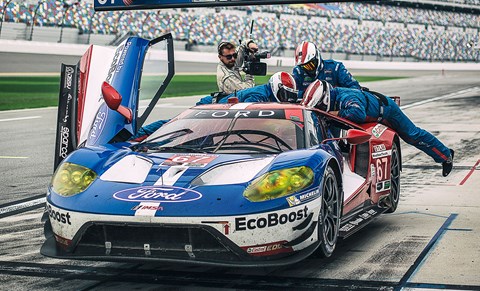
The car was running with the GTLM class elite (faster prototypes also run at Daytona but it’s the Le Mans compatible GTLM class that really matters) when the transmission refused to shift out of sixth. Less than ten laps into its debut the GT dropped behind the hard-charging Porsche 911 RSRs, Corvette C7Rs and 488 GTE Ferraris, the Ford pit so stunned they barely noticed when the other GT, the no.66 car with Joey Hand at the helm, hustled past a Porsche for the class lead.
‘We hadn’t done a race lap in the car,’ Hand will tell me later, eyes still wide after an eventful opening stint. ‘We hadn’t run with other cars and I was in the draft on cold tyres, but the balance was really good. I was pretty excited to be the first to lead a lap in the GT.’ Those moments out front will be Ford’s Daytona high watermark.
Back in the garage, quick-release bodywork falls away like boosters from an Apollo mission. Ganassi mechanics, techs from Multimatic (the group building the GT for Ford) and a transmission specialist from Ricardo climb headfirst into the car’s claustrophobic innards. The drivers, team owner Chip Ganassi and Nair look on. Quickly the issue’s tracked to a control problem – the gearbox is fine but shift requests aren’t being telegraphed to it (The road car uses an entirely different ’box to the racer, a seven-speed Getrag unit).
Away come the diffuser, rear wheels and bumper in a controlled explosion of activity. Issue resolved, the car is fired up and frantic yells clear the mass of people outside the garage. The V6 stutters, takes up the slack and then drives hard, the exhaust note a hard blare over a flatulent bass line.
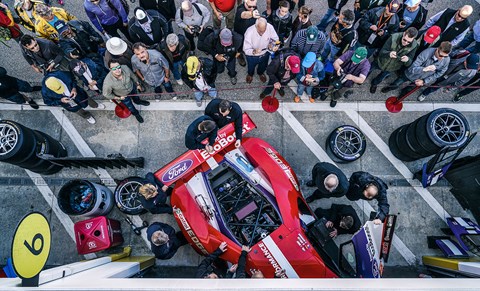
Officially the 2016 24 Hours of Le Mans starts on June 5, with an official test day a fortnight ahead of the race. For Raj Nair it started the day he took this job, back in April 2012. ‘The 50th anniversary of the GT40’s ’66 Le Mans success will only happen once – we’ve only got one shot at this,’ he tells me the night before the race. (Nair’s a passionate motorsport enthusiast with seasons in karting, Formula Ford and F2000 on his CV).
‘How could we not be involved? Sometimes I’m asked why we’re doing this, but for me it’s a silly question. Quite apart from the history and the significance of that ’66 win, Ford is founded on racing and there’s so much value in it in terms of showcasing our technology – I can’t think of another sport that is so completely about a product. F1 is about the drivers; endurance racing is about the car.
‘And while the LMP prototypes [the fastest cars in endurance racing; the GT will be shooting for GTLM class honours at Le Mans] are technical masterpieces, the technology is not relevant within a timeframe that’s of interest to customers. We needed to do a road car and a race car, and we designed the GT from the outset to do both.’
Almost immediately Nair began putting the building blocks in place. Step one was the engine. In 2013 Ford announced it’d be running its 3.5-litre EcoBoost turbo V6 in a Daytona prototype run by Chip Ganassi Racing come 2014. The declaration was met with bafflement – every other team ran a V8.
Even when the engine won its second event, at Sebring, onlookers were still left pondering the big question: why? With the announcement of the GT came the answer. Apart from their boost pressures and power outputs (near 600bhp in the prototype, a little over 500bhp in the racing GT) the two engines are identical. In short, everything Ganassi and engine gurus Roush Yates learned running the prototype would be directly applicable to the GT.
Ganassi, one of the giants of American racing, were another key component of the Nair plan. ‘They were in a very successful relationship with BMW but I wanted them on this – Ganassi’s record is proven,’ says Nair. ‘I had faith in Chip [Ganassi, team owner] and he had faith that we’d come through and deliver with the GT.’ Very quickly Nair had a proven team and an engine programme up and running. The final piece of the puzzle was the GT itself, designed and engineered in a basement Dearborn skunkworks without compromise as a super-efficient, LMP-inspired teardrop form shrink-wrapped around the compact, efficient twin-turbo V6.
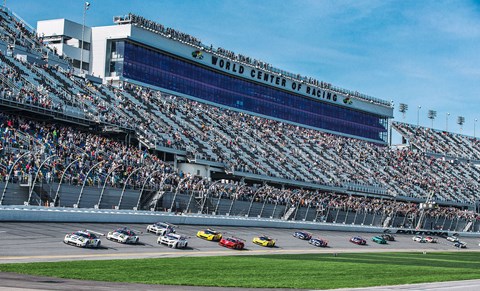
As the skies above the circuit shift from an infinite blue to the warm orange of dusk, the atmosphere is alive with noise, strobing headlights, glowing brake discs, the smoke of a thousand fire pits and the heady incense of barbecue. For Ford the GTLM standings make for grim reading. Following a similar transmission control issue on the no.66 car, the GTs are 10th and 11th in class, or last and second last. Where the GTs are eight and 17 laps down on the leader, the Porsche 911 RSR is just two laps down.
I hang on the rusty fencing at the Horseshoe as a warm Florida breeze ripples across the gravel trap. Watching the cars at work, you can’t help wondering how, given all that’s against them – fatigue, the dark, traffic, changing conditions, tyre wear – drivers like Brit Oliver Gavin in the Corvette make it look easy; spectacular speed, controlled aggression to pass the slower GT cars, no mistakes.
The Corvette C7.Rs are a force of nature to witness, bending the circuit to their will with supernatural grip and composure and grinding out of corners on a wall of V8 power. When they’re running the Fords look good too, low-slung next to their GTLM rivals and fast in the telling drag out of the infield and up onto the banking. For much of the race the no.67 car’s 1:44.391 will be the class fastest lap.
Through the night and into Sunday morning the GTs lurch between smooth running and yet more trouble. Eletrical niggles persist. Stray brake lines and loose diffusers cut tyres and prompt further unscheduled stops. Evidently luck has declared war on Ford (its Daytona prototypes also suffer, with cooling issues on one car and, on the other, brake problems that culminate in a run into the tyre wall and some hammers-and-grunting repairs) but the Ganassi team’s grim-faced resolution never falters. Little wonder Nair wanted them on his side. Prior to the race, in the nervous, quiet hours of Saturday morning, I watched them triple-check the GTs and drill pit stop procedure.
As ever on endurance racers it was the detailing that really impressed. One mechanic practised brake swaps. On the GTs the whole lot – vast ventilated Brembo discs, six-piston front calipers, inch-thick pads – comes away as one. Big alloy thumbwheels help mechanics find and release the dry-breaks in the hydraulic lines. Little lamps wired into the wheel wells help tired hands find the dry-break fittings. It’s a neat solution, proven on the Ganassi Daytona prototypes, that keeps critical components fresh.
Jessica Mace, a mechanic in the no.67 GT, practiced driver changes; holding belts out of the way, tightening them around the new driver, hooking up the radio and clipping the safety curtain across the cage. 19 seconds on the first couple of attempts dropped to 16.9. Engine guru Phil Vars, a tech with engine suppliers Rousch Yates, casually checked hundreds of parameters on a laptop as we talked. Boost pressure? ‘Not much – 1.6 bar.’ The fuel? ‘IMSA’s control VP racing fuel – E20, the same as Le Mans.’ Fuel consumption? ‘We’re not sure until they get out there – qualifying meant nothing [it was rain-lashed] and consumption varies so much with lap time. Best guess? 4-6mpg.’
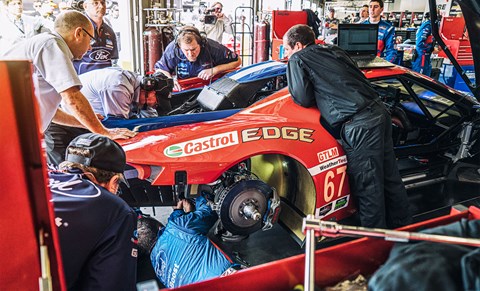
With dawn comes the biggest of the GT’s setbacks – a gearbox swap on the no.67 car, its guts laid bare on the cool garage floor. Inside the first two hours the team knew Daytona had become a test session. This stop removes all doubt. In the final hour it comes as a surprise to no one that it’s Porsche and Corvette – the two proven cars – that find themselves fighting for the GTLM win.
As the no.3 Corvette of Antonio Garcia rumbles out of the pits after the last of its stops, Earl Bamber’s 911 RSR and the second Corvette of Oliver Gavin flash past. Gavin’s clearly impatient. At the Horseshoe he sends his C7.R down the inside, tapping the 911’s tail as he nudges it wide and slips by. The RSR’s radio crackles. ‘What was that?!’ blurts Bamber. ‘This is the race – you on Gavin,’ comes the cool response.
But the Porsche can’t live with the Corvette’s pace. As Bamber drops away the second C7.R reels him in. Garcia pulls a clean pass into the Bus Stop, then sets about catching Gavin. Lap times drop half a second into the very low 1:40s. Over the radio Corvette confirms the two are free to race, though Gavin is on older rubber. After 23 hours and 54 minutes, and with no artificial yellow flag assistance, the two are nose to tail.
With less than three minutes to go Garcia blows by on the way into turn one, only to run deep and let Gavin back through. Faster prototype traffic temporarily breaks up the fight but at the line they’re back together, the winning margin at the line just 0.034 of a second. The luminous green Ligier-Honda prototype has already won overall. The two Ford GTs come in 7th and 9th in class, more than 30 laps down on the winning Corvette.
After 24 hours the noise is gone, its sudden absence discombobulating after a day and a night in its rhythmic, omnipresent company. Grimy, battle-scarred cars cool and mechanics slump as the adrenaline wanes. In what feels like the aftermath of battle, I find Michelin North America’s motorsport director Chris Baker. Involved in the GT programme from the beginning, he’s happy despite the issues. Daytona has added another 2500 miles of data to Michelin’s GT database, where it’ll join lessons learned in 50,000 of miles of testing.
What’s more, Baker’s impressed with what he’s seen. ‘The teething issues have been disappointing, sure, but this thing has the speed. It’s fast and, like the Ferrari, it’s kind on its tyres. That could be crucial at Le Mans, where Ford might be able to go to triple stints on a set of tyres sooner than the competition, saving around 20 seconds each time – a lifetime in endurance racing. As a racing platform the GT has huge potential.’
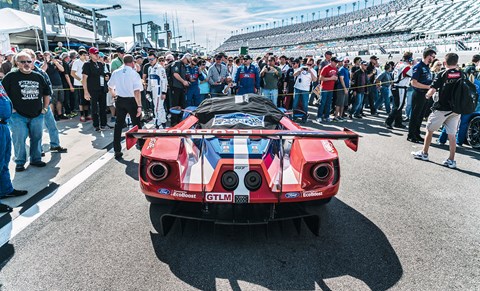
Read more from the March 2016 issue of CAR magazine